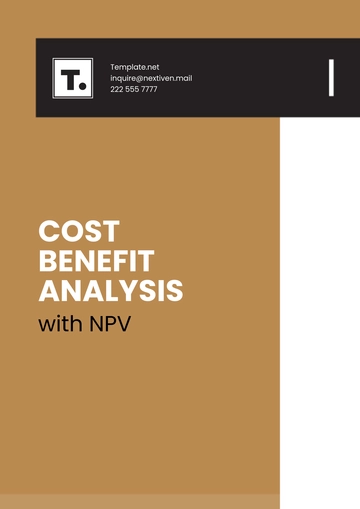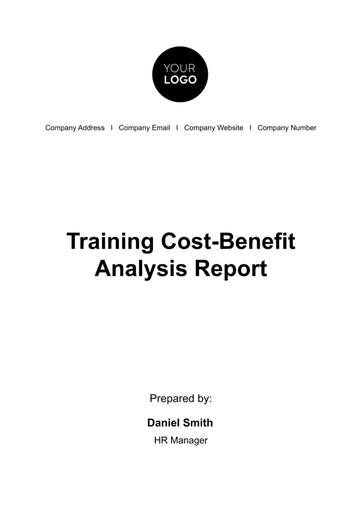Free School Financial Analysis

I. Introduction
This financial analysis report presents the annual financial performance of [Your Company Name] for the fiscal year [2052]. The report provides a detailed overview of the school's revenue, expenses, and overall financial health. The financial data is represented in tables for clarity, along with brief explanations to highlight key points and trends.
II. Previous Year Analysis
In the previous fiscal year, [2051], [Your Company Name] demonstrated positive growth in revenue, expenses, and net income compared to the preceding year. The table below summarizes the key financial metrics for fiscal years [2050] and [2051]:
Category | Fiscal Year 2050 | Fiscal Year 2051 | Change |
|---|---|---|---|
Total Revenue | $5,400,000 | $5,600,000 | +3.7% |
Total Expenses | $5,200,000 | $5,400,000 | +3.8% |
Net Income | ($100,000) | $200,000 | +300% |
The comparison reveals that [Your Company Name] experienced growth in both revenue and expenses, resulting in a significant improvement in net income. Despite the slight increase in expenses, the school effectively managed its finances to achieve a positive net income, marking a notable turnaround from the previous fiscal year's loss.
This analysis underscores the school's commitment to financial sustainability and strategic resource allocation. However, it also highlights the importance of continued vigilance and proactive measures to address any emerging financial challenges and capitalize on growth opportunities in the future.
III. Revenue Analysis
The primary sources of revenue for [Your Company Name] include tuition fees, government grants, donations, and other income sources such as fundraising activities and facility rentals. The table below provides a detailed breakdown of the revenue for the fiscal year [2052].
Revenue Source | Amount |
|---|---|
Tuition Fees | $3,500,000 |
Government Grants | $1,200,000 |
Donations | $750,000 |
Fundraising Activities | $200,000 |
Facility Rentals | $150,000 |
Total Revenue | $5,800,000 |
Tuition fees constitute the largest portion of revenue, indicating the school's financial reliance on student enrollment. Government grants and donations play vital roles in supporting educational programs and infrastructure development, while fundraising activities and facility rentals provide supplementary income. Overall, the revenue analysis underscores the school's ability to generate funds from multiple sources to sustain its operations.
IV. Expense Analysis
The main expenses for [Your Company Name] include salaries and benefits, facility maintenance, educational materials, administrative costs, and extracurricular activities. The table below details the expenses for the fiscal year [2052].
Expense Category | Amount |
|---|---|
Salaries and Benefits | $3,000,000 |
Facility Maintenance | $800,000 |
Educational Materials | $400,000 |
Administrative Costs | $350,000 |
Extracurricular Activities | $250,000 |
Total Expenses | $4,800,000 |
The largest expense category is salaries and benefits, reflecting the school's commitment to hiring qualified staff and faculty members. Facility maintenance costs demonstrate the school's investment in preserving its infrastructure to provide a conducive learning environment.
Educational materials expenditure reflects the school's dedication to enhancing teaching and learning experiences for students. Administrative costs cover essential operational expenses, while funds allocated for extracurricular activities underscore the school's commitment to holistic student development. Overall, the expense analysis illustrates prudent financial management and strategic allocation of resources to support the school's mission and objectives.
V. Net Income
The net income for the fiscal year [2052] is calculated by subtracting total expenses from total revenue.
Financial Metric | Amount |
|---|---|
Total Revenue | $5,800,000 |
Total Expenses | $4,800,000 |
Net Income | $1,000,000 |
[Your Company Name] has achieved a net income of [$1,000,000], indicating a healthy financial status for the fiscal year [2052]. This surplus is a result of effectively managing revenue and expenses, resulting in a positive financial outcome. The surplus funds can be reinvested into various school initiatives, such as curriculum enhancements, faculty development, facility upgrades, and student scholarships.
Additionally, maintaining a healthy net income ensures the school's long-term financial sustainability and resilience to economic uncertainties. Overall, the net income analysis signifies the school's fiscal strength and ability to thrive in a competitive educational landscape.
VI. Cash Flow Analysis
The cash flow analysis provides an overview of the cash inflows and outflows for [Your Company Name] during the fiscal year [2052]. This section highlights the school’s ability to manage its cash resources effectively.
Cash Flow Category | Amount |
|---|---|
Operating Activities | $1,500,000 |
Investing Activities | ($300,000) |
Financing Activities | $200,000 |
Net Cash Flow | $1,400,000 |
The cash flow analysis reveals positive cash flows from operating activities, indicating that the school's core operations generate sufficient cash to cover day-to-day expenses. Investing activities primarily involve capital expenditures for infrastructure improvements and technology upgrades, while financing activities may include obtaining loans or grants to support expansion projects or debt repayment. Overall, the cash flow analysis demonstrates the school's prudent financial management and ability to maintain liquidity to support its mission and objectives.
VII. Budget Variance Analysis
The budget variance analysis compares the actual financial performance against the budgeted figures for the fiscal year [2052]. This section identifies areas where the school performed better or worse than expected.
Category | Budgeted | Actual | Variance |
|---|---|---|---|
Total Revenue | $5,500,000 | $5,800,000 | $300,000 |
Total Expenses | $5,000,000 | $4,800,000 | $200,000 |
Net Income | $500,000 | $1,000,000 | $500,000 |
The budget variance analysis reveals that the school exceeded its revenue targets, primarily due to higher-than-expected enrollment and successful fundraising efforts. On the expense side, the school managed to control costs effectively, resulting in lower-than-budgeted expenses.
The favorable variances in both revenue and expenses contributed to a higher-than-budgeted net income, reflecting the school's strong financial performance and efficient resource management. Overall, the budget variance analysis provides valuable insights for future financial planning and decision-making to optimize resource allocation and maximize financial performance.
VIII. Financial Ratios
Financial ratios provide insights into the financial health and operational efficiency of [Your Company Name]. This section presents key ratios for the fiscal year [2052].
Financial Ratio | Value |
|---|---|
Current Ratio | 2.5 |
Debt-to-Equity Ratio | 0.3 |
Operating Margin | 17.24% |
Return on Assets (ROA) | 12.5% |
The current ratio indicates strong liquidity, ensuring the school's ability to meet short-term obligations. A low debt-to-equity ratio signifies prudent debt management and financial stability.
The operating margin reflects efficient cost management and operational performance, while the return on assets indicates the school's ability to generate income from its asset base. Overall, the financial ratios analysis confirms [Your Company Name]'s sound financial position and effective utilization of resources to achieve its strategic objectives.
IX. Recommendations
Based on the financial analysis conducted for the fiscal year [2052], the following recommendations are proposed to further enhance the financial management and sustainability of [Your Company Name]:
Diversification of Revenue Streams: Explore additional revenue sources beyond tuition fees, such as corporate sponsorships, endowment funds, and fee-based services, to reduce dependence on student enrollment and government grants.
Cost Optimization Strategies: Implement cost-saving initiatives, such as energy efficiency measures, bulk purchasing discounts, and outsourcing non-core activities, to streamline expenses and improve operational efficiency.
Investment in Technology: Allocate funds for upgrading technology infrastructure and integrating digital learning tools to enhance teaching effectiveness, student engagement, and administrative processes.
Strengthen Fundraising Efforts: Develop comprehensive fundraising campaigns targeting alumni, parents, local businesses, and philanthropic organizations to increase donations and sponsorships for school programs and initiatives.
Financial Education Program: Introduce financial literacy programs for students, parents, and staff members to promote responsible financial management practices and foster a culture of financial accountability within the school community.
Regular Financial Monitoring: Establish a system for ongoing financial monitoring and performance evaluation to identify potential risks, opportunities, and areas for improvement in a timely manner.
By implementing these recommendations, [Your Company Name] can enhance its financial sustainability, adaptability, and competitiveness in an evolving educational landscape, ensuring continued success and excellence in fulfilling its mission and serving its stakeholders effectively.
X. Conclusion
The financial analysis of [Your Company Name] for the fiscal year [2052] provides a comprehensive overview of the school's financial performance and position. The analysis demonstrates prudent financial management, strategic resource allocation, and a commitment to long-term sustainability and growth.
By effectively managing revenue, controlling expenses, and maintaining a healthy surplus, [Your Company Name] is well-positioned to continue delivering high-quality education and serving its students, faculty, and community effectively. This report serves as a valuable tool for stakeholders, guiding strategic decision-making and ensuring the school's continued success in the years to come.
- 100% Customizable, free editor
- Access 1 Million+ Templates, photo’s & graphics
- Download or share as a template
- Click and replace photos, graphics, text, backgrounds
- Resize, crop, AI write & more
- Access advanced editor
Evaluate your school's financial health with the School Financial Analysis Template, available exclusively on Template.net. This fully editable and customizable template, fully compatible with our Ai Editor Tool, enables you to perform an in-depth financial analysis, detailing income, expenses, and financial projections for informed decision-making. Download our template now!





























